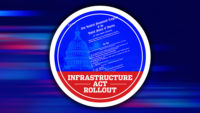The Infrastructure Act Rollout
FHWA Announces 22% Boost in Core Highway Funding From IIJA
Update: Lack of Full-Year Highway Obligation Cap Raises Concerns

The FHWA's Dec. 15 announcement of $52.5 billion in funding for core highway programs marks the largest such distribution in decades, according to the agency.
In one of the first milestones in carrying out the Infrastructure Investment and Jobs Act, the Federal Highway Administration has released tables showing how much each state may benefit from a significant overall increase in core highway programs for the new law’s first year, fiscal 2022.
FHWA announced the funding in a notice issued on Dec. 15, exactly one month after the IIJA was signed into law.
The $52.5-billion total apportionments is the largest annual amount in decades, according to FHWA. [View state-by-state table here.]
It also represents an increase of about 22% from the 2021 level of $43.2 billion, ENR calculates, using figures from the American Association of State Highway and Transportation Officials.
Brian Turmail, Associated General Contractors of America vice president for public affairs and strategic initiatives, told ENR via email, “This is an important next step in implementing the bill.”
Jay Hansen, National Asphalt Pavement Association executive vice president for advocacy, said via email, “The tables are really important for the state transportation departments to start planning their 2022 construction season.”
Top 5 states
Texas will receive the largest share among the states, with $5.17 billion. California ranks second, with $4.86 billion; Florida is third, with $2.51 billion.
New York ranks fourth, with $2.22 billion; Pennsylvania is fifth, with $2.17 billion.
FHWA Deputy Administrator Stephanie Pollack said in the notice to states about the apportionments that the funding is available immediately and can be obligated to projects until Sept. 30, 2025.
The tables also break down the totals among various categories. By far the largest is the National Highway Performance Program, which totals $28.4 billion, or 54% of the grand total of all apportioned categories.
The allotments, which are allocated by a statutory formula, do not include some other IIJA highway and bridge programs. Notable exceptions are several existing and new grant programs which the U.S. Dept. of Transportation will award via competitions among states, cities and other applicants.
Hansen says the release of the apportionments "is just the first step."
The obligation limit problem
Congress has yet to approve an overall full-year 2022 cap on highway obligations, which limits the rate at which highway funds can be used by the states. It is up to appropriations committees to set the obligation limit but lawmakers have not passed spending bills for the full fiscal year 2022.
Instead, they have turned to short-term stopgap measures, the most recent of which is scheduled to expire on Feb. 18.
Susan Howard, AASHTO program director for transportation finance, says, "It's a problem that we don't have a full year of appropriations and a full year of obligation limitations."
Howard said in an interview that under the current stopgap bill, "States can only obligate $14.1 billion of the total of $52.5 billion in highway contract authority." She adds, "It doesn't allow us to realize the full impact of the funding increases included inf IIJA for fiscal year 2022."
As of now, Howard says she doesn't expect the reduced obligation cap to have a major impact on state transportation departments' highway project bid lettings. She says most states' lettings for the annual construction season tend to get into gear in late February or early March.
"So, we're not in danger of losing that window entirely, yet." Howard says. "The projects are there. We have plenty of projects to fund."
Howard adds, however, "If we go past February 18th without more certainty, I think it will be more of a concern.".
There is another issue related to the lack of a full-year obligation ceiling. AGC's Turmail says, "The obligation limitation issue will have the biggest impact on the new programs that are intended to improve air quality and make our infrastructure more resilient to climate change."
These are the PROTECT program—for Promoting Resilient Operations for Transformative, Efficient and Cost-Saving Transportation—and the Carbon Reduction Program (CRP).
In the FHWA notice, Pollack points out that the stopgap spending measure bars using its funding for any project that wasn't funded in fiscal 2021. That would include projects under PROTECT and CRP, which didn't exist in 2021.
Turmail adds, "We are hopeful that Congress can fix this issue by February before the start of the construction season so states can see the full benefits of the bill."
Looking ahead, Hansen says, “The next big step is getting guidance from the FHWA about the [IIJA’s] changes in existing programs and guidance on the new programs."
He says state transportation agencies “have lots of questions" about the new law and industry also "is still absorbing the bill."
Hansen adds, "That is why guidance is absolutely critical for a successful implementation of the programs in the [IIJA.]”
Story updated on 12/16/2021 with comments from AASHTO.





